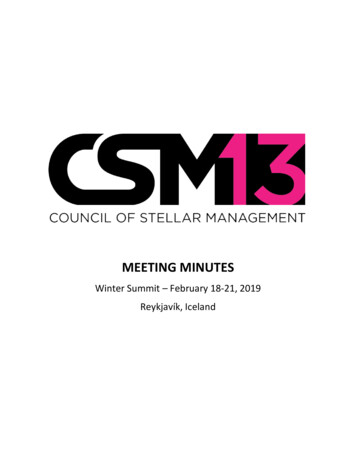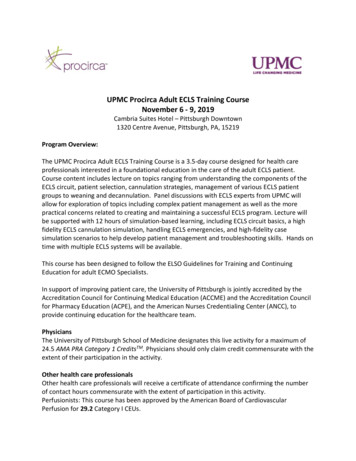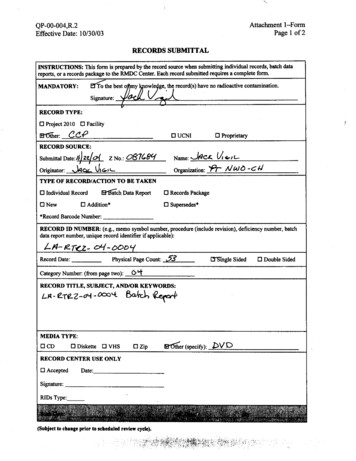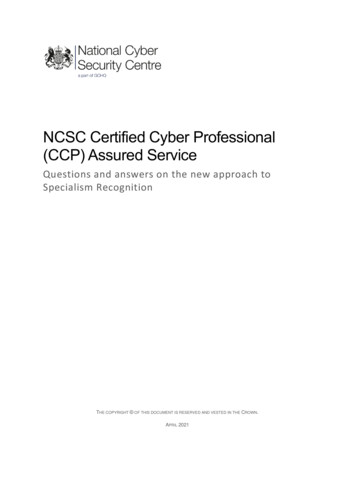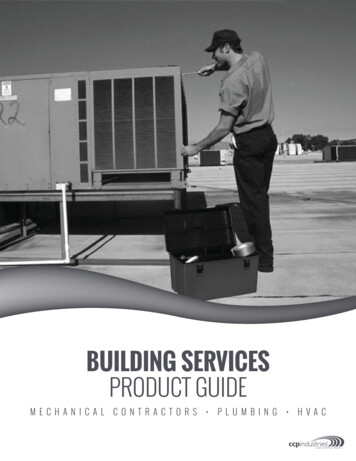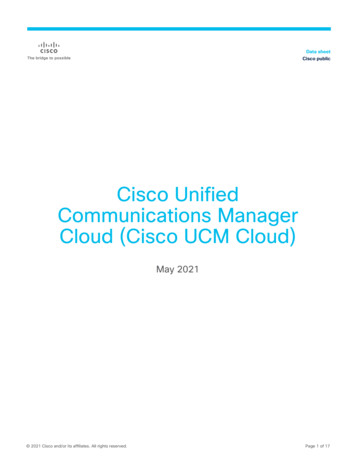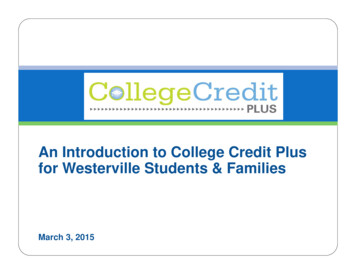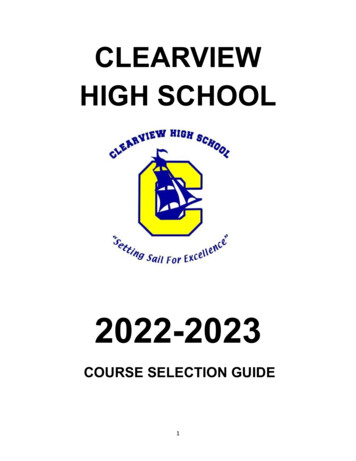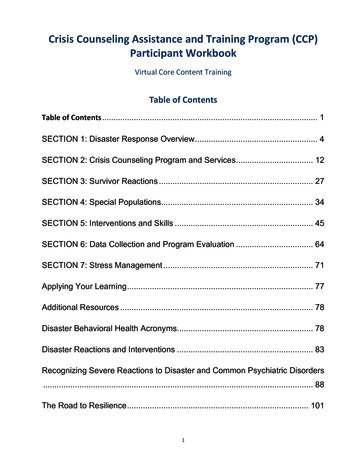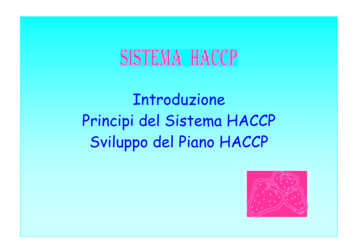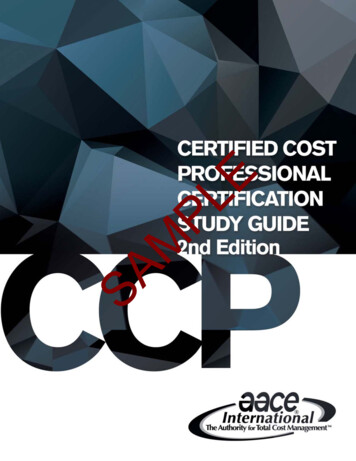
Transcription
EPLMSA
CCPCertification Study GuideSecond EditionECompanion Workbook to Skills & Knowledge of Cost Engineering, 6th EditionPLDr. Makarand Hastak, PE CCP, EditorM2016SACCP Certification Study GuideSecond EditionCopyright 2006-2016byAACE International1265 Suncrest Towne Centre Drive, Morgantown, WV 26505-1876, USAPhone: 1.304.2968444 Fax: 1.304.2915728 E-mail: education@aacei.org Web:www.aacei.org1
A Publication ofCCP Certification Study GuideSecond EditionDr. Makarand Hastak, PE CCP, EditorEA continuing project of the AACE International Education BoardMPL2015/2016 Education Board Members:Peter W. Griesmyer, FAACE (Chair)Dr. Nadia Al-AubaidyDr. Baabak Ashuri, CCP DRMPMichael BensussenChris A. Boyd, CCP CEPDr. John O. Evans III, PSPDr. Makarand Hastak, PE CCPMarina G. Sominsky, PSPJames G. Zack Jr., CFCC, FAACE AACE Hon. Life, VP – Education BoardSAContributing Members:Nelson E. Bonilla, CCP FAACEMark T. Chen, PE CCP FAACE AACE Hon. LifeClive D. Francis, CCP FAACE AACE Hon. LifeJohn Jeffrey Hannon, CEPKatherine HullMarlene M. Hyde, CCP EVP FAACEDonald F. McDonald Jr., PE CCP PSP FAACEEkaterina PujanovaNeil D. Opfer, CCP CEP PSP FAACESunu M. Pillai, Esq. CCP EVP PSPStephen O. Revay, CCP CFCC FAACEEx-Officio Members:John Hines, AACE Manager, Education and Staff Liaison to the Education Board2
AACE International Publications Staff:Formatting and Layout: Marvin Gelhausen, Managing EditorCover Design: Noah Kinderknecht, Art DirectorCassandra LoPiccolo, Social Media and Publications InternEditorial Team:Editor:Dr. Makarand Hastak, PE CCPSAMPLEAssociate Editors:Chris A. Boyd, CCP CEPMark T. Chen, PE CCP FAACE AACE Hon. LifeDr. John O. Evans III, PSPClive D. Francis, CCP FAACE AACE Hon. LifePeter W. Griesmyer, FAACESean T. Regan, CCP CEP FAACERohit Singh, PE CCPJames G. Zack, Jr., CFCC FAACE AACE Hon. Life3
Table of ContentsSAMPLEPREFACE. 5SECTION 1 – COST. 8Chapter 1 – Cost Elements . 9Chapter 2 – Pricing and Costing . 15Chapter 3 – Materials. 20Chapter 4 – Labor . 26Chapter 5 – Engineering Role and Project Success . 33Chapter 6 – Machinery, Equipment, and Tools. 38Chapter 7 – Economic Cost . 44Chapter 8 – Activity-Based Cost Management . 50SECTION 2 – COST. 56Chapter 9 – Cost Estimating . 57Chapter 10 – Process Product Manufacturing . 64Chapter 11 – Discrete Part Manufacturing . 73SECTION 3 – PLANNING AND SCHEDULING . 82Chapter 12 – Project Planning. 83Chapter 13 – Scheduling . 90SECTION 4 – PROJECT AND COST CONTROL . 98Chapter 14 – Earned Value Overview . 99Chapter 15 – Performance and Productivity Management . 104SECTION 5 – PROJECT MANAGEMENT . 109Chapter 16 – Project Management Fundamentals . 110Chapter 17 – Project Organization Structure . 115Chapter 18 – Project Communications . 120Chapter 19 – Project Labor Cost Control . 127Chapter 20 – Leadership and Management of Project People . 137Chapter 21 – Quality Management. 143Chapter 22 – Value Engineering . 148Chapter 23 – Contracting For Capital Projects . 153Chapter 24 – Strategic Asset Management . 160Chapter 25 – Change Management Practical Guide . 167Chapter 26 – Overview of Construction Claims and Disputes . 172SECTION 6 – ECONOMIC ANALYSIS, STATISTICS, PROBABILITY AND RISK . 179Chapter 27 – Financial and Cash Flow Analysis. 180Chapter 28 – Practical Corporate Investment Decision-Making Guide . 190Chapter 29 – Statistics & Probability. 199Chapter 30 – Optimization . 205Chapter 31 – Risk Management Fundamentals . 211Chapter 32 – Risk Management Practical Guide . 217Chapter 33 – Total Cost Management Overview . 222Chapter 34 – The International System of Units (SI). 228APPENDICES . 232APPENDIX A – Sample Exam Questions . 233APPENDIX B – Values of the Standard Normal Distribution Function . 253APPENDIX C – Discrete Compound Interest Tables . 2554
PREFACEThe Certified Cost Professional (CCP) Certification Study Guide, 2nd Edition (CSG-2) is a companionworkbook to the Skills and Knowledge of Cost Engineering, 6th Edition (S&K-6). The design and layoutof this study guide is intended to assist readers in testing their knowledge of cost engineering byoffering practice problems and questions related to the subject matter addressed in S&K-6. Firstpublished in 1996 as the CCC/CCE Certification Study Guide, the CCP Certification Study Guide hasgone through several revisions and changes. In 2013 the name of the study guide was changed to theCCP Certification Study Guide to reflect the consolidation of CCC/CCE credentials by AACEInternational. For the latest information on all of the AACE certifications, visit the AACE Internationalwebsite at: www.aacei.orgEHow to Use this BookThe chapters and topics presented in this publication correspond to specific chapters in the Skills andKnowledge of Cost Engineering (S&K-6). The reader should use this publication in conjunction withS&K-6. Together, these publications provide readers with the knowledge base expected of a costengineering professional as outlined in Recommended Practice 11R-88, Required Skills andKnowledge of Cost Engineering and the TCM Framework, 2nd Edition. This publication has two specificobjectives:MPL1. To provide a summary of specific knowledge areas and the associated key terms that a costengineering professional should comprehend, at a minimum, when preparing for theCertified Cost Professional (CCP) certification exam.2. To provide sample problems and questions for each topic area, as well as the associatedanswers, to exercise the reader’s understanding of the concepts and skills presented in S&K6.SAThe S&K-6 and CCP CSG-2 are companion publications which serve as reference texts for individualspreparing for the Certified Cost Professional (CCP) and other AACE International certificationexaminations. To further assist in preparation, the reader should visit the AACE International websiteat www.aacei.org for updates to the CCP certification as well as Recommended Practice 10S-90, CostEngineering Terminology.Readers should begin their examination preparation by first studying the material presented in S&K-6and then working out the sample problems and questions in the CCP CSG-2. The summary and keyterms found in each chapter offer a checklist of the comprehensive knowledge needed to fullyprepare for the examination. Readers may have to go back and forth between the two publicationsto gain a full understanding of the subject matter as they attempt the exercise problems andquestions. Please note that the actual certification examination questions are likely to address skillsand knowledge from multiple chapters; therefore, a thorough understanding of the material is vitallyimportant. In addition, the CCP CSG-2 includes several key appendices such as: (1) sample examquestions, (2) values of the standard normal distribution, and (3) the discrete compound interesttables.AcknowledgementsThis work is an undertaking of the AACE Education Board. A work of this magnitude and qualitycannot be completed without dedicated contributions from (i) the Education Boardchampions/associate editors who identified subject matter experts and diligently followed up withthem to write and/or revise the chapter summaries and the related questions, (ii) all the authors fortheir contribution to this publication, (iii) the reviewers who methodically evaluated each chapter foraccuracy and depth of questions covered, as well as, (iv) my graduate students - Sayanti5
Mukhopadhyay and Saumyang Patel and all the AACE staff who worked with me and contributedcountless hours in making this project successful. My special thanks are due to Mark Chen and JohnHines for their support and dedication in getting this project completed. Mark Chen’s managementand diplomatic skills were particularly helpful in keeping the entire team on track toward thesuccessful completion of this publication. It has been an honor to have worked with all thesededicated individuals and I sincerely appreciate their efforts and support throughout this project.We hope you find this publication to be of value. The Education Board welcomes any comments andsuggestions you might have in improving the Certification Study Guide (CSG-2) as well as the Skillsand Knowledge of Cost Engineering (S&K-6).SAMPLEProf. Makarand Hastak, Ph.D., PE, CCPPurdue UniversityOctober 20156
CONTRIBUTORSPricing and CostingRohit Singh, P. Eng. CCPMaterialsNeil D. Opfer, CCP CEP PSP FAACELaborMorris E. Fleishman, PE CCPFAACEEngineering Role and ProjectSuccessNeil D. Opfer, CCP CEP PSP FAACEMachinery, Equipment, andToolsDr. Carl C. ChrappaEarned Value OverviewSean T. Regan, CCP CEP FAACEOverview of Construction Claimsand DisputesJohn C. Livengood, Esq., AIA CCPCFCC PSP FAACEJames G. Zack, Jr., CFCC FAACEAACE Hon. LifePerformance and ProductivityManagementDr. James M. Neil, PE CCP AACEHon. Life (Deceased)Rohit Singh, P. Eng. CCPProject ManagementFundamentalsJames A. Bent, CCP (Deceased)Madhu P. Pillai, CCPSean T. Regan, CCP CEP FAACENeil D. Opfer, CCP CEP PSP FAACEProject Organization StructureJames A. Bent, CCP (Deceased)Madhu P. Pillai, CCPSean T. Regan, CCP CEP FAACEProject CommunicationsJoseph A. Lukas, PE CCPMEconomic CostsNeil D. Opfer, CCP CEP PSP FAACEChange Management PracticalGuideSean T. Regan, CCP CEP FAACEProject Labor Cost ControlDr. Joseph J. Orczyk, PE CCPSean T. Regan, CCP CEP FAACESAActivity-Based Cost ManagementGary CokinsCost EstimatingLarry R. Dysert, CCP DRMP FAACEAACE Hon. LifeFinancial and Cash Flow AnalysisDr. Scott J. Amos, PEPractical Corporate InvestmentDecision-Making GuideJ. D. (Jim) Whiteside, II, PE FAACEECost ElementsFranklin D. Postula, PE CCP FAACEAACE Hon. Life (Deceased)Chris A. Boyd, CCP CEPSchedulingAnthony J. Werderitsch, PE CCPCFCC FAACE AACE Hon. LifeStatistics and ProbabilityDr. Elizabeth Y. ChenMark T. Chen, PE CCP FAACEAACE Hon. LifePLEditorDr. Makarand Hastak, PE CCPLeadership and Management ofProject PeopleDr. Ginger LevinMadhu P. Pillai, CCPOptimizationDr. Robert C. Creese, PE CCPRisk Management FundamentalsAllen C. Hamilton, CCPRisk Management PracticalGuideAllen C. Hamilton, CCPTotal Cost ManagementOverviewLarry R. Dysert, CCP DRMP FAACEAACE Hon. LifeProcess Product ManufacturingDr. Kenneth K. Humphreys, PECCP FAACEQuality ManagementGary CokinsDiscrete Part ManufacturingDr. Robert C. Creese, PE CCPValue EngineeringNeil D. Opfer, CCP CEP PSP FAACEThe International System ofUnits (SI)Kurt G. R. Heinze, P. Eng. CCPFAACE AACE Hon. LifeProject PlanningJames A. Bent, CCP (Deceased)Jennifer Bates, CCP FAACE AACEHon. LifePeter W. Griesmyer, FAACEContracting for Capital ProjectsJames G. Zack, Jr., CFCC FAACEAACE Hon. LifeAACE Publications StaffMarvin GelhausenNoah KinderknechtStrategic Asset ManagementJohn K. Hollmann, PE CCP CEPDRMP FAACE AACE Hon. LifePurdue Graduate StudentsSayanti MukhopadhyaySaumyang Patel7
SECTION 1 – COSTSAMPLEChapter 1: Cost ElementsChapter 2: Pricing and CostingChapter 3: MaterialsChapter 4: LaborChapter 5: Engineering Role and Project SuccessChapter 6: Machinery, Equipment, and ToolsChapter 7: Economic CostChapter 8: Activity-Based Cost Management8
Chapter 1 – Cost ElementsFrank D. Postula, PE CCP FAACE AACE Hon. LifeIntroduction/Learning ObjectivesCost is one of the three fundamental attributes associated with performing an activity or the acquisitionof an asset. These are: price (cost), features (performance), and availability (schedule). The key learningobjectives are: E Understand what makes up cost – i.e., the basic resources (material, labor, etc.) that are neededto perform an activity or create an asset.Understand the distinction between cost elements that are directly applied to an asset andthose that are indirectly applied.Relate the cost elements to the life cycle of the asset: acquisition, use and disposal.Use the understanding of cost elements to further understand how cost is measured, applied,and recorded to arrive at the total activity and/or asset cost.Apply the knowledge gained to solve problems related to cost element source and definition.Terms to KnowMActivityAssetCostCost categoriesCost elementsCost objectivesDirect costsFixed costsIndirect costsProjectResourcesVariable costsWork breakdown structure (WBS)SA PL Key Points for Review Conceptso Cost engineering is the application of scientific principles and techniques.o What are the key activities that generate cost when they are performed or that define plans andprocesses that cause (or influence) cost to be generated in other activities and/or assets?o What are the elements that make up cost?o How are these cost elements categorized and how do they relate to one another?o Why is it important to collect and account for costs as they relate to specific activities andassets?9
oHow to apply these cost elements and categories to the insight for managing activities andassets? Cost Definitiono Cost is the value of an activity or asset.o Resources used are categorized as material, labor, and “other.”o The value of the asset may also include the cost elements of scrap material or manufacturingspares, construction form-work and expendable safety items, as well as the cost of transportingthe material to the work site. Materialo Material is the physical composition of the asset. However, the value of the asset may alsoinclude the cost elements of scrap material or manufacturing spares, construction form workand expendable safety items, and the cost of transporting the material to the work site.E Laboro Labor as the value of the work needed to complete the activity or asset.PL Othero The “other” cost category is resources that are needed to support the activity and/or asset.CategorySAMaterialLaborM Cost Category and Value of Asseto Another important aspect of cost relates to whether one is the producer or consumer of anactivity or asset.o The value of an asset or activity may also be related to intangible costs.OtherCost Element ExamplesPen, desk, lumber, etc.Draw plans, order materials,installation, etc.Permit fees, gas, truck, etc.receivematerials, Cost Structureo It is important to further structure the cost elements within the material, labor, and otherresource categories in order to understand how they influence the total cost of the activity orasset and to get a better understanding of how they can be controlled. GroupingThe cost elements can be grouped into direct costs, indirect costs, fixed costs, and variable costs.ooDirect costs are those resources that are expended solely to complete the activity or an asset. Inother words, any cost that is specifically identified with a particular final cost objective, but notnecessarily limited to items that are incorporated in the end product as material or labor isconsidered direct cost.Indirect costs are those resources that need to be expended to support the activity or asset, butare also associated with other activities and assets. In other words, any cost not directly10
oooidentified with a single final cost objective, but identified with two or more final cost objectives.Indirect costs may also be referred to as “overhead costs” or “burden costs.” Indirect costs aregeneral administrative activities associated with operating the business, costs for providing andmaintaining field equipment or a manufacturing facility, and expenses for utilities, taxes, legalservices, etc.Fixed costs are those cost elements that must be provided independent of the volume of workactivity or asset production that they support. These can be either direct or indirect costs.Variable costs are those cost elements that must be provided and are dependent on the volumeof work activity or asset production that they support. Again, these can be either direct orindirect costs.Grouping examples can be found in Chapter 1, Skills and Knowledge of Cost Engineering, 6thEdition, Tables 1.2 and 1.4.PLE Cost Accounting Definition:o Cost accounting is defined as the historical reporting of disbursements, costs and expenditureson a project.o Recording of cost information is nothing more than the mechanical gathering of data in aroutine manner.o Become familiar with the code of accounts structure.o Activity based costing assigns resources to activities.o Work breakdown structure (WBS) can be used with code of accounts. Be familiar with thestructure.oooCost Estimating: This is the prediction of the quantity and cost of resources needed toaccomplish an activity or create an asset.Cost Trending: Cost trends are established from historical cost accounting information. Costmanagement questions may focus on how expenditures are trending relative to physicalaccomplishments.Cost Forecasting: Forecasts are much like estimates. Whereas an estimate is always for futureactivities and assets, forecasts are prediction of the cost at completion for cost elements thatare in progress.Life-Cycle Costing: Life-cycle costs (LCC) are associated with an asset and extend the costmanagement information beyond the acquisition (creation) of the asset to the use and disposalof the asset.SAoM Cost ManagementThe four common methods for providing cost information as they apply to cost management are asfollows:11
Check on Learning1. are those cost elements that must be provided and dependent on the volume ofwork activity or asset production that they support.A.B.C.D.Direct CostsIndirect CostsFixed CostsVariable Costs2. is a method of cost element classification where resources are assigned toactivities that are required to accomplish a cost objective.ECode of AccountsSummary Level AccountsActivity Based CostingWork Breakdown StructurePLA.B.C.D.Direct CostsIndirect CostsFixed CostsVariable CostsSAA.B.C.D.M3. are those cost elements that must be provided independent of the volume ofwork activity or asset production that they support.4. are those resources that are expended solely to complete the activity or asset.A.B.C.D.Direct CostsIndirect CostsFixed CostsVariable Costs5. are associated with an asset and extend the cost management informationbeyond the acquisition (creation) of the asset to the use and disposal of the asset.A.B.C.D.Life-Cycle Costs (LCC)Indirect CostsFixed CostsVariable Costs12
6. are those cost elements that must be provided and difficult to appropriate as adirect cost on specific assets that they support.A.B.C.D.Direct CostsIndirect CostsFixed CostsVariable Costs7. The work breakdown structure (WBS) can be an effective aid for which type of communications?TeamCompanyCustomerAll of the aboveEA.B.C.D.8. Which of the following is a key reason to use a work breakdown structure (WBS)?PLOrganize the workPrevent work from slipping through the cracksProvide a basis for estimating the projectAll of the aboveMA.B.C.D.9. Which of the following is not an example of a variable?SizeShapeStamping toolWeightSAA.B.C.D.10. Procurement planning involves:A.B.C.D.A make or buy decisionAnswering supplier’s questionsCreating the contractCreating the RFP13
SolutionsDVariable CostsRefer to Chapter 1, “Cost Structuring” topic2.CActivity Based CostingRefer to Chapter 1, “Cost Structuring” topic3.CFixed CostRefer to Chapter 1, “Cost Structuring” topic4.ADirect CostRefer to Chapter 1, “Cost Structuring” topic5.ALife-Cycle Costs (LCC)Refer to Chapter 1, “Cost Management” topic6.BIndirect CostRefer to Chapter 1, “Cost Structuring” topic7.DAll of the aboveRefer to Chapter 1, “Cost Structuring” topic8.DAll the aboveRefer to Chapter 1, “Cost Structuring” topic9.CStamping toolRefer to Chapter 1, “Cost Structuring” topic10.ASAMPLE1.A make or buy decisionRefer to Chapter 1, “Cost Management” topic14
Chapter 2 – Pricing and CostingRohit (Roy) Singh, P.Eng. M.Ed., CCPIntroduction/Learning ObjectivesThis chapter highlights the difference between pricing and costing. It is very important to distinguishbetween the terms “price” and “cost.” There is a very fine difference between them, which is whypeople often tend to use them interchangeably. This chapter discusses the concepts of pricing andcosting of a project, illustrates the differences and helps the reader to identify the inputs, transformingmechanisms and outputs related to the costing and pricing process. The key learning objectives are:E Differentiate between costing and pricing.Identify the inputs, transforming mechanisms and outputs related to the cost and pricingprocess.Understand the budgeting process.Calculate financial ratios related to the costing and pricing of projects.Understand the reasoning behind the costing and pricing process outputs.Terms to KnowMCash flowCompetitive advantageCostFinancial managementInputsOpportunity costOutputsPriceProfitReturn on assets (ROA)Return on investment (ROI)Transforming mechanismSA PL Key Points for Review Costing and Pricingo Costing follows scope determination and quantification and precedes pricing and budgeting.o Cost can be categorized into direct or indirect cost.o Direct costs are those that are specific and tangible to the project, and include the costs ofmaterials, labor, equipment, etc.o Indirect costs are those costs not directly accountable or tangible to the project, such asbusiness taxes, home office overhead, or transportation fleet distributed cost.o Pricing can be defined as the determination of the amount to be charged to the client including: Direct cost15
oo Budgeting processo Activity cost estimateso Scope baselineo Project scheduleo ContractsEoPLo Indirect cost Contingency ProfitSeller vs buyer perspective determines price vs cost – e.g. 100,000 transaction 100,000 is the price including profit from seller’s perspective 100,000 is the cost from the buyer’s perspectiveCost-Pricing Process Inputs WBS/Scope Historical records Vendor quotationsTransforming mechanism (Tools and techniques) Cost and pricing strategies Financial managementOutputs Project estimate Project acquisition Business decisionSAM Forecastingo Applying earned value methodo Using Cost Performance Index (CPI) to calculate Estimate at Complete (EAC)o Early prediction of overrun when EAC is higher than Budget at Completion (BAC) Financial managemento Return on investment (ROI)o Return on assets (ROA)o Net profit margin Project Acquisition and Business Decisiono Review financial ratios (e.g. ROI, ROA, net profit margin) to determine the validity of acquisitionsand support business decisions.16
Check on Learning1. Which of the following is not a major step in the Cost-Pricing process?A.B.C.D.InputsTransforming mechanisms (Tools & Techniques)OutputsBid award2. Which item is not a major output to the Cost-Pricing process?A.B.C.D.Project EstimateProject acquisitionBusiness decisionResource loaded CPM scheduleLaborMaterialSite overheadEquipmentPLA.B.C.D.E3. Which item is not considered a direct cost?Quantity take-offsCost reportsCompetitor pricingBid breakdownsSAA.B.C.D.M4. Historical records for costing and pricing a project does not include:5. Inputs to the costing- pricing process do not include:A.B.C.D.Scope of workHistorical recordsVendor quotationsSales forecasts6. Inputs to the budget development process include:A.B.C.D.Activity cost estimatesScope baselineProject scheduleAll of the above17
7. Which financial management tool is best for comparing projects in the same industry?A.B.C.D.Net profit marginReturn on assetsGross profit marginBreak-even analysis8. In regards to the difference between price and cost, which statement is incorrect?MPLEThe vendor’s price is the cost to the contractorThe vendor’s price plus the contractor’s markup is the cost to the clientThe bid price to the owner is the contractor’s costThe subcontractor quote is the contractor’s costSAA.B.C.D.18
SolutionsDBid AwardRefer to Chapter 2, “Cost-Pricing Process” topic & Figure 2.22.DResource Loaded ScheduleRefer to Chapter 2, “Cost-Pricing Process” topic & Figure 2.23.CSite Overhead is not considered a direct costRefer to Chapter 2, Figure 2.14.CCompetitor pricingRefer to Chapter 2, “Historical Records” topic5.DSales ForecastsRefer to Chapter 2, “Inputs” topic & Figure 2.26.DAll of the aboveRefer to Chapter 2, “Budgeting” topic7.BReturn on AssetsRefer to Chapter 2, “Financial Management” topic8.CThe bid price to the owner is the contractor’s costRefer to Chapter 2, “Conclusion” topicSAMPLE1.19
CCP Certification Study Guide . Second Edition . Dr. Makarand Hastak, PE CCP, Editor . A continuing project of the AACE International Education Board . 2015/2016 Education Board Members: Peter W. Griesmyer, FAACE (Chair) Dr. Nadia Al-Aubaidy . . How to Use this Book. The chapters and topics presented in this publication correspond to specific .
